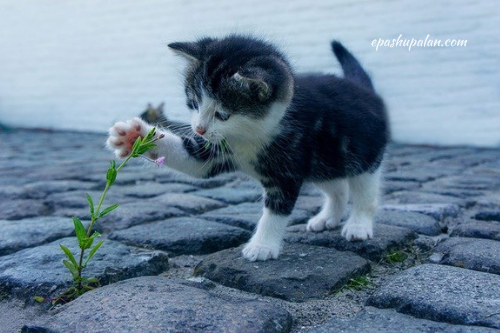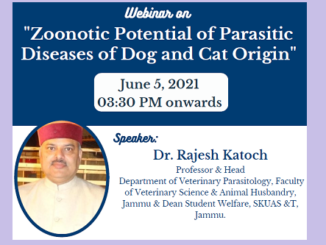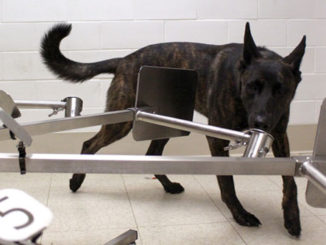Introduction
Feline enteric coronavirus infection is usually mild infection characterized by inapparent enteritis in kittens or occasionally in older cats. The group of feline coronaviruses consists of two very similar viruses: feline infectious peritonitis virus (FIPV) and feline enteric coronavirus (FECV). Feline coronaviruses belong to the Coronaviridae family which, order of the Nidovirales and genus Alphacoronavirus. The virus has been found to infect several members of the Felidae including domestic cats, lions, cheetahs, mountain lions and European wildcats. Two pathotypes or biotypes of feline coronaviruses exist: feline enteric coronavirus or FECV and feline infectious peritonitis virus or FIPV. FIPV emerges most likely through mutation of FECV. Genetic predisposition also plays a role in FIP disease susceptibility. Cheetah, a species of non-domestic feline, is especially vulnerable to FIPV infection. This is likely due to its homogeneous population and lack of MHC I polymorphism.Within the domestic species, there are some purebred cats that have a higher risk of FIPV infection namely Abyssinians, Bengals, Birmans, Himalayans, Ragdolls and Rexes. Moreover, gender predisposition has been recorded where male cats are being found to be more sensitive to FIPV infection.
Pathology of FECV and FIPV
Feline coronavirus infection typically occurs through the oro-fecal route with virus infecting the columnar epithelial cells of the intestines. Although FECV is mainly restricted to the gut, it also has been detected in the blood, lymphoid tissue, bone marrow and thymus, lungs, brain and liver. After infection, cats start shedding virus after one to three days. There are three types of shedding: recovery, recurrent shedding, and persistent shedding. The first type of shedding stops (recovery), a second type of shedding has exaggerated non-shedding periods (intermittent shedding).

FECV can mutate into FIPV, which is why FECV infection is important. Higher FECV titers logically have more chance to acquire the mutation(s) necessary for FIPV development. Therefore, cats with immature or compromised immune systems, who have 10-100 times higher FECV titers, has more chance of developing FIP. Up to 12% of the cats seropositive for FCoV, develop FIP, with a near 100% mortality. The mutation that transforms FECV to FIPV leads to an enhanced monocyte/macrophage tropism.
In FIP, there are two forms, the effusive or wet form is characterized by the presence of effusion in one or more body cavities (thoracic, abdominal, pericardiac) due to inflammation of visceral serosae and omentum. In dry form there is formation of granulomatous lesions on parenchymatous organs such as kidneys, intestines, and liver. However, most naturally infected cats, have pathologic features that are neither exclusively granulomatous nor effusive but rather a mixture of both the forms. During a FIPV infection, cats show a general lymphopenia as a result of the depletion of lymphoid organs such as the spleen and mesenterial lymph nodes and apoptosis of activated lymphocytes. It has also been found that antibodies remain highly detectable for several months after inoculation and do not offer protection from reinfection with the same or another FECV strain, resulting in equivalent amounts of virus shedding.
Mechanisms of cellular immunity in protection of felines
The cellular immune response plays a key role in protecting cats against FIPV since the humoral immune response does not protect against the infection. Depending on the strength of the cell-mediated immune response (CMI), a disease would not occur, a partial CMI would lead to the dry disease form, and no CMI would result in the wet disease form. Furthermore, delayed-type hypersensitivity (DTH) responses to intradermal injection of FIPV in symptomatic as well as asymptomatic animals shows a weak DTH response or no response at all in symptomatic cats, while a positive DTH-reation in all asymptomatic cats. The strength of the DTH reaction is correlated to the outcome of the disease. A strong positive DTH reaction seems to prevent illness, while a weaker and absent DTH reaction gives the granulomatous and effusive form of disease.
- Lymphocyte proliferation
When a host is invaded by pathogens, the CMI will react by activating an arsenal of lymphocytes (e.g. CD4+, CD8+, natural killer (NK) and regulatory T cells (Tregs)). Some of these activations occur through presentation of viral antigens on antigen presenting cells (APC) in the lymphoid tissues. Following activation, innate effector cells (NK cells) will immediately eliminate infected host cells. Other lymphocytes will start proliferating (lymphocyte proliferative response (LPR)) for several days and subsequently differentiate into effector cells, after which they set out to eliminate cells infected by the viral pathogen.
The degree of protection of FECV and FIPV infection by CMI is highly variable. The variation depends on both the efficiency of the cats’ immune system and the virulence of the virus strain involved. In cats, the technique of in vitro restimulation of T lymphocytes is used to evaluate the immunologic competence. On stimulation with FIPV-antigen, seropositive cats shows a LPR while the seronegative cats do not. Further studies whether the cellular immunity is able to eliminate virus-infected cell can be determined by cytotoxicity assay where detection of apoptosis in target cells in vitro can be performed.
- Cytokines
During a viral infection, several interferons are produced as well (IFN-α, IFN-β and IFN-ɣ) that are believed to act in vivo by blocking the spread to uninfected cells. In addition, cytokines such as IL-2, IL-4, IL-10, IL-12, and granulocyte-macrophage colony stimulating factor (GM-CSF) are produced by and act on the B, T and NK cell-mediated immunity. The cytokine production can have several effects on the host and its immune response such as pyrogenic reaction, activation of complement opsonisation, initiation of the acute-phase reaction, and stimulation of adaptive immune responses.
In FIPV infection, IL-10, a notable anti-inflammatory cytokine, is a potent suppressor of cellular immunity. When produced, it inhibits the TH1 response of T cells and the cytokine release of macrophages. Essentially, it enhances the antibody-based B cell response which is typical of a FIPV infection. In contrast, the release of IL-12 actually supports the cellular immune response by inducing CD4 T cell differentiation to the TH1-type and enhancing NK cell / cytotoxic T lymphocyte (CTL) activity. In addition, during FIPV infections an overproduction of TNF-α is also observed which leads to induction of apoptosis of lymphocytes. A co-expression of TNF-α and lesions together with an increased expression of TNFR-I and TNFR-II on CD8+ T cells in seen in FIP infected cats. Vasculitis in cats due to FIPV infection is mainly due to TNF-α which upregulates endothelial adhesion molecules such as VCAM-1. Moreover, an upregulation of IFN-ɣ, a potent mediator of cellular immunity from lesions and tissues is seen in FIPV-infected cats. This indicates that CMI is involved in the pathogenesis of FIP at tissue level while high levels of IFN-ɣ in the blood still can protect against infection. IFN-ɣ can mediate activation of macrophages and an increased macrophage Fc-receptor-mediated activity. These actions contribute to the antibody-dependent enhancement of disease (ADE).
- NK cells
Natural killer cells (NK cells) are a specialized cell-type of the innate immunity known for their cytolytic effect against tumors or cells infected with an intracellular pathogen. Besides this property, they also possess the capacity to interact with other cells (e.g. dendritic cells, CD4+ and CD8+ T cells) by which they can influence later adaptive responses. Playing an important role in the complex interactions and regulations of the immune system, it is of no wonder that NK deficiencies in mammals lead to recurrent and life threatening viral and microbial infections. NK cells also play a role in the severity of illness during infection with viruses such as herpes virus, hepatitis B virus, and HIV. Even immunological memory cannot develop completely without the help of NK cells.
More specifically, in cats, infection with feline immunodeficiency virus (FIV) leads to strongly reduced NK cell activity and frequency. The NK cells could be important because they also possess Fc receptors by which they could eliminate a cell through antibody-dependent cell-mediated cytotoxicity (ADCC). This requires viral proteins to be expressed in the membrane of infected cells which are recognized by the mounting humoral immune response. This protein gives rise to a lowered amount of neutrophils and complement in blood in addition to a down-regulation of NK cell activity which might play a role in the pathogenesis of FIP. Finally, the low IL-12 and IL-18 levels associated with FIP in combination with the involvement of transforming growth factor β (TGF-β) in the FIPV-induced lymphopenia can be linked to decreased NK cell activity since IL-12 and IL-18 are both enhancers of NK cell responses in contrast to TGF-β that is a typical suppressor of NK cell activity. Recent advancements in amplifying NK cell responses by increasing NK cell number and activity could give the innate as well as the adaptive CMI the chance to fight an infection with FIPV. These advancements include the addition of cytokines such as IL-2, IL-12, IL-15, IL-18 and IL-21, the administration of 1-acid glycoprotein, a protein with an anti-inflammatory and immunomodulatory character, is found in higher concentrations in the blood of cats infected with FIPV drugs and antibody therapeutics such as thalidomide, imatinib mesylate, rituximab and daclizumab, and a NK cell-based adoptive immunotherapy.
- Regulatory T cells
Tregs were first discovered more than forty years ago. Thymic lymphocytes were found to be crucial in restraining autoimmunity and mediating suppression of immunity . It is known that cats possess Tregs in blood, spleen and lymphoid compartments and they can be characterized by the expression of CD4, CD25 and Foxp3. A more recent study also investigated the feasibility of Treg depletion for the treatment of FIV. The basic suppressive mechanisms used by Tregs can be divided into four models: production of inhibitory cytokines, induction of cytolysis, inducing metabolic disruption and modulation of APC maturation or function. In the first mechanism, three inhibitory cytokines, IL-10, IL-35 and TGF-β stand central as mediators of Treg function. However, their relative importance differs depending on distinct immunological settings. IL-10, a known immune regulatory cytokine, has potent anti-inflammatory capacities and is known to down modulate Th1 responses. However, its contribution to Treg function is not fully understood and probably depends on the target organism and/or disease and the experimental setup. Similarly, the role of TGF-β in Treg function is only evident in in vivo settings, and less clear in vitro. Its function primarily lies in inducing Foxp3 expression, Treg maintenance and inhibition of T cell activation. Additionally, IL-35, a relative novel cytokine has also been found to be important in Treg function and homeostasis.
Conclusion
The degree of protection by CMI is highly variable. The variation depends on both the efficiency of the cats’ immune system and the virulence of the virus strain involved. The virus does not respond to conventional antivirals and therapeutics. Neither antivirals such as ribavirin nor immune-modulators such as prednisolone or interferon could be proven to be effective. Hence, treatment of FIP is mainly symptomatic. Currently, one commercial temperature-sensitive attenuated FIPV strain (DF2) vaccine against FIPV is available and is administered intranasally. But immunodominance could contradict the efficacy of the existing vaccine in the field, varying from 0% to 75%. Therefore, pro-active management seems to be the best way to fight a FIPV infection. Proper prevention should therefore aim to avoid exposure to FECV. After all, FIPV arises from FECV through mutation. Precautions that can be taken are mainly focused on hygiene to minimize FCoV spread. A sufficient amount of litter trays, which are frequently cleaned, has to be available. They should be placed in rooms at a long distance from the food and water bowls. In addition, stress reduction and early weaning can also prevent or minimize the spread of FcoV.
References
- Text book of Preventive Veterinary Medicine and Epidemiology by RD Sharma, M Kumar and MC Sharma, Indian Council of Agricultural Research, New Delhi.
- Vermulen, B.L. and Nauwynchk, H.J. (2013). The Role of Cell – mediated immunity during coronavirus infection in cats: opprtunities for therapeutic avenues? Ph.D Thesis submitted to Faculty of Veterinary Medicine, Ghent University.
- Jolanda D. F. DE Groot-Mijnes, Jessica M. VAN Dun, Robbert G. Van der Most and Raoul J. DE Groot. Natural History of a Recurrent Feline Coronavirus Infection and the Role of Cellular Immunity in Survival and Disease, Virol. 2005, 79(2):1036.
| The content of the articles are accurate and true to the best of the author’s knowledge. It is not meant to substitute for diagnosis, prognosis, treatment, prescription, or formal and individualized advice from a veterinary medical professional. Animals exhibiting signs and symptoms of distress should be seen by a veterinarian immediately. |






Be the first to comment